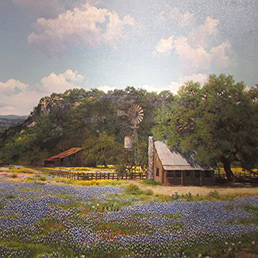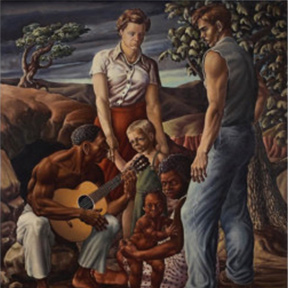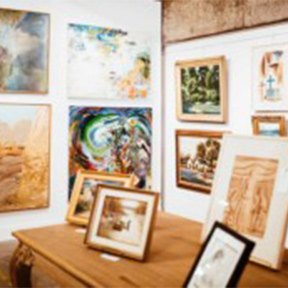- (214) 720-4044
- info@daviddike.com
- Mon - Fri: 10 am - 5 pm
Culwell, Ben
Ben Culwell
(Am. 1918-1992)
“It is for the important average that I want to speak, the rank and file. The general nature of the use I try to make of the art of painting is, I hope, apparent: that is, to express the sum of relationships which is a total human being. With art, as with atomic physics, the big problem in the world today is to bring the human being abreast of the techniques and the inventions of his material culture—to achieve an adequate modern spiritual integrity.” Ben Culwell, in “Fourteen Americans” catalogue, 1946/Museum of Modern Art
Ben Culwell was a figure within the first generation of Abstract Expressionism, a movement which began in the early 1940s and became a dominant style in American painting from the late 1940’s into the 1950s. Culwell, whose career was based in Texas, continued to develop his body of Abstract Expressionist paintings into the later 20th century.
Ben Culwell’s art studies in his youth inspired him to early recognize his “calling” as an artist—importantly in classes with Eleanor Benners, a “remarkable” Dallas high school teacher and artist, and in his further studies from 1934-1941 at Dallas Art Institute, SMU, and Columbia University where his studies with Walter Pach in 1936 introduced him to abstraction, surrealism, cubism, and expressionism.
In 1941, some seven weeks before the Japanese attack on Pearl Harbor, Culwell was drafted into the U. S. Navy and entered World War II. He arrived at Pearl Harbor aboard ship not long after the attack, and he was given the job of burying the dead.
It could be said that the young artist forged his artistic identity and even his unique abstract expressionist approach to painting in the crucible of war during his five years of wartime service. Culwell, still in his early twenties, began to express with any materials on hand his experiences as a front-line warrior aboard the heavy cruiser “Pensacola”, his ship for most of the war. He became eye-witness to the South Pacific battles known to history as Pearl Harbor, Tassafaronga, Guadalcanal, Tarawa, the Gilbert Islands. In one traumatic instance, during the Battle of Tassafaronga, on the night of November 30, 1942, Culwell’s ship the Pensacola was torpedoed and half the crew of 1,300 were killed.
“[After]…my third consecutive year [1944] of combat duty” [aboard the battle scarred Pensacola], Culwell later wrote, “ I had reached the positive balance requisite to creative statement. I had completed my personal adjustment. Then, as the stimuli recurred from day to day in the well-known cycle of battle-routine-battle, I set down relationships of the life I was in…Previous quick sketches done in direct but unstable reaction were finished at that time”.
Culwell’s wartime paintings, made under battle conditions in a unique abstract and expressionist style during WWII, were quickly recognized as a rare artistic testament destined for national recognition. The paintings received their first exhibition in 1945 at Dallas Museum of Fine Arts, curated by the noted regional artist and then museum director Jerry Bywaters. In 1946, with these wartime works, Culwell made his dramatic and well-reviewed New York debut in “Fourteen Americans” at The Museum of Modern Art, soon after his 28th birthday, in the company of Robert Motherwell, Arshile Gorky, David Hare, Isamu Noguchi, Saul Steinberg, and Mark Tobey. In the now legendary postwar “Americans” shows at MOMA that followed Culwell’s, all curated by Dorothy C. Miller, the art world also noted the prophetic early appearances of Jackson Pollock, Mark Rothko, Clyfford Still, Franz Kline, Jasper Johns, and Robert Rauschenberg.
Paradoxically, after his critical recognition in New York as an artist of notable talent and promise, Culwell’s maverick spirit and war weariness drove him away from living and exhibiting in New York and back to Texas where he maintained two careers, as artist and businessman. His business success in insurance and furniture manufacturing allowed him the choice of not actively pursuing a commercial career in art. Culwell continued, however, to paint and exhibit in Texas until 1989 and built up a large body of well received exhibited work.
Among the pioneering Abstract Expressionists, Culwell became, like Clyfford Still, one of the least associated with the New York scene. Only two other artists from Texas—Forrest Bess and Joseph Glasco—are associated with the historical development of Abstract Expressionism.
What remains artistically important and the mainstay of Culwell’s postwar work is his continuing development of a dramatic and painterly abstract surface—with its daring gesture, color, and texture—a mindscape which exists in and for itself and is as well a source of deeply layered and buried image. The range of method and materials that he permitted himself throughout his career, combined with his receptivity to novel possibilities, often led him to anticipate pictorial devices that we usually think of as the inventions of other artists. Culwell dripped paint in 1942, before Pollock, and continued doing so after Pollock’s untimely death. He used sand before Tapies; mirrors and bric-a-brac before Rauschenberg; the shaped canvas before Stella. Over a 40 year period, fueled by an almost frantic assurance and energy, Culwell channeled the electric flow of his life onto canvas, ceaselessly revising the here and now into poems of everyday experience.
Ben Culwell’s paintings have been featured in important institutional exhibitions, including: Dallas Museum of Art (Solo-1945); Museum of Modern Art (Group-1946); San Antonio Men of Art Guild (Solo-1959); Dallas-Fort Worth Men of Art Guild (Solo-1959); Owen Art Center at Southern Methodist University & other Texas museum venues (Group-1971); McNay Art Museum (Retrospective Solo-1977); Archer M. Huntington Art Gallery at the University of Texas Austin & other Texas museum venues (Group-1983); The Menil Collection (Solo-1987); Cultural Activities Center Temple (Retrospective Solo-1978&1989); and Museum of Fine Arts Houston (Group-1995&1996). His works are in the collections of the mentioned museums and in notable corporate and private collections.
SOURCES
Fourteen Americans Museum of Modern Art, 1946. (Curated by Dorothy C. Miller, ed./ with statements by the artists)
Paintings by Ben L. Culwell Marion Koogler McNay Art Institute [now McNay Art Museum], 1977. (Curated & Introductory essay by Dan Wingren)
Texas Images and Visions Huntington Art Gallery at University of Texas Austin & other Texas venues, 1983. (Curated & Catalogue by Becky Duval Reese; Essay “Images of Texas” by William H. Goetzmann )
Adrenalin Hour—The South Pacific, World War II: Ben L. Culwell The Menil Collection, 1987. (Curated & Introductory essay by Walter Hopps)
Ben L. Culwell, Retrospective: Paintings from 1946 to 1989 Cultural Activities Center (Temple, Texas), 1989. (Curated by Hershall Seals, with an essay “Ben L. Culwell” by Donald Kuspit )
Alison de Lima Greene. Texas, 150 Works from Museum of Fine Arts, Houston. Harry Abrams, New York, 2000
John and Deborah Powers. Texas Painters, Sculptors & Graphic Artists: A Biographical Dictionary of Artists in Texas before 1942. Woodmont Books, Austin, 2000 ( Fred R. Kline, Fred R. Kline Gallery, Santa Fe, NM )
SOLD - Ben L. Culwell (Am. 1918-1992) | Pollen Count High 1957-1979 | oil, lacquer & glass on masonite 27 1/2 x 48 - SOLD
SOLD - Ben L. Culwell (Am. 1918-1992) |Visage Comprised c. 1957 | oil, epoxy & lacquer on masonite 30 x 24 - SOLD
SOLD - Ben L. Culwell (Am. 1918-1992) | Untitled c. 1957 | oil & lacquer on masonite 41 x 18 - SOLD
SOLD - Ben L. Culwell (Am. 1918-1992) | Black Circle, White Triangle 1960-1974 | oil and lacquer on masonite 35 1/2 x 48 - SOLD
SOLD - Ben L. Culwell (Am. 1918-1992) | Middle Age c. 1958 | oil, lacquer, epoxy, metal bolt on masonite | 34 1/4 x 48 - SOLD
SOLD - Ben L. Culwell (Am. 1918-1992) | The High Country 1965-1979 | oil, epoxy & lacquer on masonite 48 x 34 - SOLD
SOLD -Ben L. Culwell (Am. 1918-1992) | Everyday 1955-1963 | oil, laquer & glass on masonite 29 x 45 SOLD
SOLD - Ben L. Culwell (Am. 1918-1992) | Pollen Count High 1957-1979 | oil, lacquer & glass on masonite 27 1/2 x 48 - SOLD-1
SOLD - Ben L. Culwell (Am. 1918-1992) | Greenings of a Moment 1956-1959 | oil, l acquer & glass on masonite | 48 x 24 - SOLD
SOLD - Ben L. Culwell (Am. 1918-1992) | Management Struggle c. 1957 | oil, lacquer & glass on masonite 48 x 24 -SOLD





